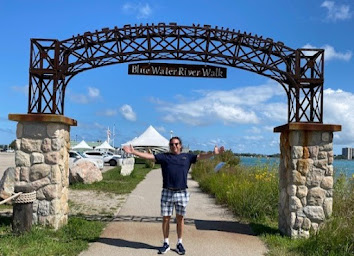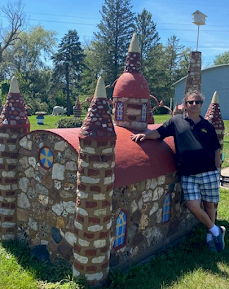Are we having fun yet? That is an undeniable YES! So much fun that we must start planning for our next trip as we continue to explore America. Most likely we’ll be leaving after Thanksgiving and will head south, and I think we will try to extend our trip to about 100 days of travel. To make this trip possible we will have to move the camper south before winter settles into New England. Campers can survive in freezing temperatures, but they need to be fully occupied with a steady supply of electricity and propane. Prolonged weather with temperatures in the teens leaves the potential for damage. We could “winterize” the camper which involves draining all tanks and adding antifreeze to the lines. In warmer temperatures we would clear the lines and refill the tanks. Which is a bit of a hassle and a lot of work. That means we will be moving the camper south the last week in October, on a brief 8-day trip, where it will remain until our return in December.
I guess we
should also tell you that we have named the camper. Yep... Sorry to say it, but much like people
place names on sterns of their boats, we have assigned a name to the 5th
wheel camper.
The camper is called “Neil”, as in Neil the Northpoint
We were first made aware of this practice whilst in Wabasha, Minnesota; and, at first, we dismissed the idea as being a bit silly. Predictably, we started testing out names, and just kind of smirking at the absurdity of it all. Eventually, when we were planning to move the camper south, it was becoming tedious for us to repeatedly refer to the “camper”, or the “Northpoint”, or the “5th Wheel”, so we just started referring to it as “Neil” as in “Neil the Northpoint”. And, Ta-da, before you know it, just like that, you have named your camper. Ridiculous? Yes, we know, but we’re retired now, and our standards are lower.
We were traveling again on a Monday to 1,000 Islands, Canada, and I can say that after experimenting with different travel days, Mondays & Thursdays have become our preferred travel days. 1,000 Islands is in the province of Ontario and consists of a series of towns that follow the St. Lawrence Water Way, just across the border from northern New York. This was the last stop on our Great Lakes tour. We were at the northernmost point of Lake Ontario. We had a great time, and the weather really cooperated with us; we had some hot days, but also some nice, sunny, and warm days.
On a really hot day we decided to take a sightseeing boat excursion through the thousand islands on both the Canadian and US sides of the St. Lawrence Water Way. It was interesting being on a Canadian sightseeing vessel, with mostly French speaking Canadians on holiday. We traveled into US territorial water on the sightseeing tour and then we came back to a Canadian dock in Gananoque, Ontario, so it was like we were traveling internationally. Fun factoid: The 1,000 islands is more like 1,800 islands and more islands are under Canadian control than American control. That being said, the land mass is essentially equal, which means American controlled islands are bigger, but there are hundreds of smaller Canadian islands. And can you believe that all this was negotiated peacefully in 1783??? The tour circled Boldt Island, which contains both a castle and a yacht house; however, it is a US territory, so we were not able to disembark and walk the island grounds without a passport. The history of Boldt Castle is a real-life tale of love and heartbreak. At the turn-of-the-century, George C. Boldt, millionaire proprietor of the Waldorf Astoria Hotel in New York City, set out to build a full-size Rhineland castle in Alexandria Bay, on picturesque Heart Island. The castle was to be a display of his love for his wife, Louise. 300 workers, including stonemasons, carpenters, and artists, fashioned the six story, 120 room castle, complete with tunnels, a powerhouse, Italian gardens, a drawbridge, and Alster tower (children’s playhouse). Not a single detail or expense was spared. In January 1904, tragedy struck. Boldt telegraphed the island and commanded the workers to immediately “stop all construction.” Louise had died suddenly. A broken-hearted Boldt could not imagine his dream castle without his beloved. Boldt never returned to the island, leaving behind the structure as a monument of his love. The grounds and gardens of the island were stunning, even from our perch on the tour boat, and I am sure that one day we shall return from the American side and walk through the castle and stroll the grounds.
A few days later, we took a short car ride south to Kingston, Ontario, where we got a 2 1/2 hour tour of the Kingston Penitentiary. Of all the museums we have visited on our trip so far, this one was a bit more surreal. First off, the facility, and it is a huge facility, is still operated under the jurisdiction of the federal Canadian prison system. This is Canada's oldest maximum-security prison, originally opening in 1835 and finally ceasing operation in 2013. The limestone walls and buildings of the prison were quarried locally by the prisoners themselves, and the entire compound is over 21 acres, abutting Lake Ontario. Many prisoners in the early 19th century were transported to prison by boat. What made this tour especially memorable is that we met retired prison guards from the facility who volunteered to give the tours and tell of their individual and actual experiences at the prison. We were specifically told not to try to close the prison doors, because they would lock, and the cell keys were not easily available. Let’s just say that I walked around with my hands in my pockets most of the time.
 |
| Kingston Penitentiary |
The best part about being so close to northern New York is that we got to see family again. Cousin Beth and her husband Rick from Syracuse, NY, drove north about 90 minutes, crossed over into Canada, and spent the day with us at the KOA campsite. We had great weather which allowed us to have a picnic lunch, go to the pool, and have a wonderful fireside dinner eating outside under the stars. We had so much fun with them and were sad to see them leave later in the evening. And a couple days after that, we too were packing up Neil (as in “Neil” the Northpoint. Don’t make me repeat myself ‘cause I will. LOL!) as our time in 1,000 Islands, Canada was ending. This was our 11th stop of a 12-stop road trip. How unbelievable is that? We have just one more stop on our Industrial Midwest and Great Lakes tour, as we stop on the shores of another large lake, Lake Champlain, in Shelburne, VT. We will get a chance to visit with our #1 son, Josh, and visit a couple of very interesting museums, and take a cheese tour. But this will have to wait until the next blog post, as we tell… the Rest of the Story.






















